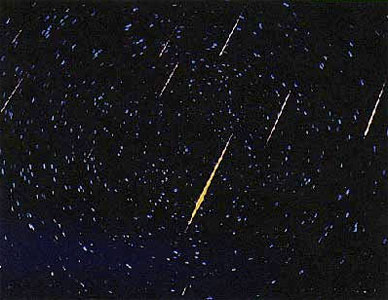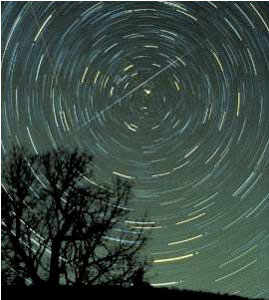A page from the "Causes of Color" exhibit...
Shooting stars

Meteors and meteor showers
A meteor is a falling star, or shooting star, caused when a meteorite (a rock or dust particle) or asteroid ignites upon hitting the earth’s atmosphere.
Meteors are bright and white in color, but using spectroscopy to separate the constituent colors in this light provides valuable information about their composition through their emission spectrum “fingerprint.”
A meteorite may come from a comet, remnants from an asteroid collision, or another form of space debris. Light is emitted when friction with the gas particles in our atmosphere sets the falling object alight. A meteor brighter than the planets in the sky is known as a fireball. Asteroids are pieces of rock far smaller than planets, most orbiting the sun in a belt between Mars and Jupiter.
Most meteorites are destroyed by the heat of friction as they penetrate the earth’s atmosphere. The small fraction that reach the earth’s surface are of enormous interest, as they allow us to chemically analyze their composition and refine the information we have gleaned from their spectra.
In early 2009, pieces of meteorite were linked to a specific asteroid, known as 2008 TC3, which had collided with the earth’s atmosphere. This created a rare opportunity to confirm what the meteorite and asteroid reflectance spectra indicated about its composition.

|

|
|
These spectacular meteor showers are leonids (they appear in the constellation of Leo). In the picture at right, the circular trails mark the path of stars around the celestial north pole through the course of a long exposure photograph, while the straight line marks the path of a meteor. |
|



